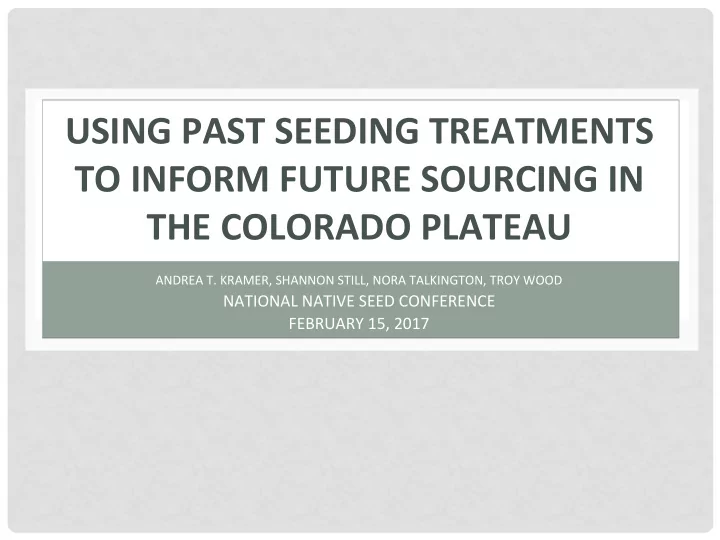

USING PAST SEEDING TREATMENTS TO INFORM FUTURE SOURCING IN THE COLORADO PLATEAU ANDREA T. KRAMER, SHANNON STILL, NORA TALKINGTON, TROY WOOD NATIONAL NATIVE SEED CONFERENCE FEBRUARY 15, 2017
MANY THINGS INFLUENCE SEEDING OUTCOMES • Management • Composition, diversity, and source of plant species used • Propagule type used, timing and method of application • Invasive species control • Use of prescribed disturbances (e.g., fire, grazing) • Site-specific and temporal factors • Land use history • Composition of surrounding landscape • Weather Knutson et al. 2014. Long-term effects of seeding after wildfire on vegetation in Great Basin shrubland ecosystems. Journal of Applied Ecology 51 :1414-1424. Grman et al. 2013. Confronting contingency in restoration: management and site history determine outcomes of assembling prairies, but site characteristics and landscape context have little effect. Journal of Applied Ecology 50 :1234-1243.
COLORADO PLATEAU RESTORATION OUTCOMES DATABASE (CPROD) Compile seeding treatment data (incl species & sources) & pre- and post-treatment monitoring data • WRI = Utah Watershed Restoration Initiative (WRI) incl monitoring data from Utah Division of Wildlife Resources Range Trend Project • LTDL = USGS Land Treatment Digital Library • NPS = National Park Service • BLM = Bureau of Land Management field offices 669 seeding treatments applied between 2000 and 2015 88 well pad 190 post-fire 391 other
COLORADO PLATEAU RESTORATION OUTCOMES DATABASE (CPROD)
CONTRIBUTIONS TO THE SEED STRATEGY Goal 1: Identify seed needs, and ensure the reliable availability of genetically appropriate seeds. Objective 1.1: Assess the seed needs of federal agencies and the capacity of private and federal producers. Action 1.1.1: Conduct an assessment of seed needs for all Federal agencies and their offices that provide or use seed.
SPECIES DEMAND • More than 80% of treatments had species-level details Non-nativ Non-nativ Non-nativ Non-nativ e grass e forb e grass e forb • 80 NPS seeding treatments had very different diversity and sourcing approaches • Top species by seed number: Sporobolus cryptandrus • Top species by # of treatments: Achnatherum hymenoides
DEMAND VOLUME & VALUE 3.2 million pounds of $14.6 million dollars seed (1.7 trillion seeds) Non-nativ Non-nativ Non-nativ Non-nativ e grass e forb e forb e grass
DEMAND VOLUME & VALUE Non-nativ Non-nativ Non-nativ Non-nativ e forb e grass e grass e forb
CONTRIBUTIONS TO THE SEED STRATEGY Goal 2: Identify research needs and conduct research to provide genetically appropriate seed and to improve technology for native seed production and ecosystem restoration. Objective 2.4: Develop or modify monitoring techniques, and investigate long-term restoration impacts and outcomes Action 2.4.1: Analyze new and existing methodologies to evaluate restoration outcomes.
CONNECTING TREATMENTS TO OUTCOMES • Complete data for 153 seeding treatments (23% of 669) • Pre-treatment monitoring data (or identified control) most often missing • Many monitoring approaches, so success = present • Focus on native species used • Analyses to identify whether lifeform, species, or source significantly explains variation in success • Ultimate (future) goal to tie species & source uses with broader outcomes (resistance to invasion, resilience after disturbance, etc)
SEEDING OUTCOMES - LIFEFORM • Lifeform significantly explains variation in success.
SEEDING OUTCOMES - SPECIES • Species significantly explains variation in success.
SEEDING OUTCOMES - SOURCE • Source significantly explained variation in success. Species Release # treatments % present Sodar 6 0% Elymus Critana 11 36% lanceolatus *p < 0.005 Bannock 15 67% Composite Single Single release source source from WA, release release OR, and ID from MT from OR (1995) (1954) nrcs.usda.gov (1971)
SOURCE USE OVER TIME nrcs.usda.gov NO DATA
NEED MORE DATA!
EXPERIMENTAL SEEDING TRIAL NEAR GRAND JUNCTION, CO
NEW WINNING SPECIES
EXPERIMENTAL SEEDING TRIAL NEAR MOAB, UT
TREATMENT EFFECTS ON NATIVE (SEEDED) GRASS COVER • If outcome = presence of seeded species, seeding significantly increased cover of seeded native grasses
TREATMENT EFFECTS ON (TOTAL) NATIVE PLANT COVER • If outcome = cover of all native species, herbiciding & seeding did not have a significant effect (herbicide killed forbs)
SEEDING EFFECTS ON KNAPWEED COVER • If outcome = invasion resistance, seeding significantly decreased cover of Russian knapweed ( Acroptilon repens ) after 2 growing seasons. Swcoloradowildflowers.com
CONCLUSIONS • Value in compiling seeding treatments data • Past demand can help predict future need • Assessing outcomes remains challenging but worthwhile • More data needed – how can we do this strategically? • Be intentional about following new releases through use - especially in regions like the CP as new materials made available • Can help illustrate costs/benefits of different materials • Capitalize on experimental seeding trials within larger treatments when possible • Collaborations, access to sites and seeds, and time
THANK YOU! • Data collection and entry: Elizzabeth Kaufman • Data locators/providers: Kevin Gunnell, Justin Welty, Judy Perkins, Nikki Grant-Hoffman, Dale Beckerman, Nate West, Ken Holsinger, Matt Dupire, Gabe Bissonette, James Ivory, Mark Paschke, Katie Sandbom, Adrienne Pilmanis, Sandra Borthwick, Laura Schrage • Seed providers: Ken Holsinger, Jim Garner, Robby Henes, Sheila Williams • Experimental seed trial site support: Nikki Grant-Hoffman and Anna Lincoln (BLM GJFO), Hau Truong and Zach Lundeen (Bonderman Field Station at Rio Mesa) • Support: Bureau of Land Management Plant Conservation Program QUESTIONS? Andrea Kramer: akramer@chicagobotanic.org
The preceding presentation was delivered at the 2017 National Native Seed Conference Washington, D.C. February 13-16, 2017 This and additional presentations available at http://nativeseed.info
Recommend
More recommend